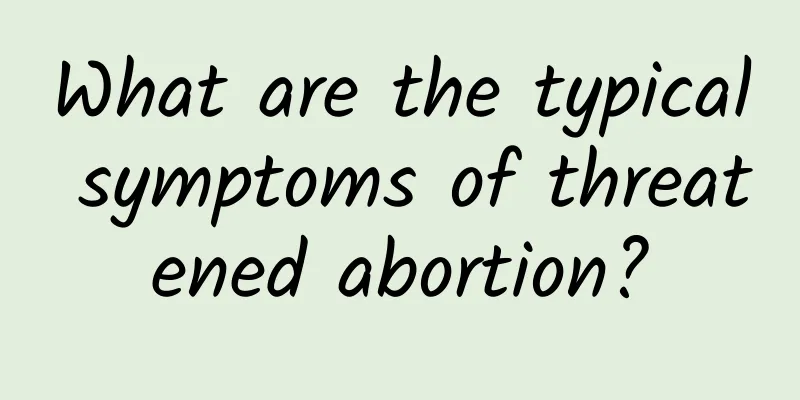What are the typical symptoms of threatened abortion?

|
Typical symptoms of threatened abortion include vaginal bleeding, lower abdominal pain or distension, lower back pain, etc. When these symptoms occur, you should seek medical attention promptly to get a clear diagnosis and take appropriate measures to preserve the fetus. 1. Vaginal bleeding: This is the most common sign of threatened abortion, usually manifested as a small amount of vaginal bleeding, mostly bright red or dark red, and may be accompanied by bloody discharge. Some pregnant women bleed less, sometimes similar to menstrual flow, but this situation should not be ignored, because even slight bleeding may indicate that the gestational sac is threatened. If the amount of bleeding increases or is accompanied by blood clots, you should seek medical attention immediately. 2 Lower abdominal pain or distension: Some pregnant women may experience persistent or intermittent pain or distension in the lower abdomen, which may be similar to menstrual pain. This symptom often indicates that the uterus is undergoing atypical contractions, which may have an important impact on the instability of the fetus. If the pain worsens or spreads to the lower back, seek medical help as soon as possible. 3. Waist pain: Waist pain is also a common early sign, but it is more likely to be ignored than other symptoms. In the early stages of pregnancy, many pregnant women will feel slight waist discomfort due to uterine expansion and hormonal changes, but if this pain is significantly intensified or accompanied by other symptoms, you should be more vigilant. 4Other possible symptoms: Some pregnant women may experience systemic symptoms such as nausea, fatigue, dizziness, etc. These are usually related to hormone fluctuations in the body. When the symptoms are too obvious, check as soon as possible. The following measures can be taken to deal with the above symptoms: Drug treatment: Depending on the situation, your doctor may recommend tocolytic drugs, such as oral or injected progesterone, to help stabilize the pregnancy. Rest and fetal protection: Reduce activity, avoid lifting heavy objects and standing for long periods of time. It is recommended to rest in bed to reduce pressure on the fetus. Medical examination: B-ultrasound examination is used to clarify the development of the embryo, and the levels of β-HCG and progesterone in the pregnant woman's blood are monitored to provide a reference for treatment. When any abnormal symptoms are found, it is crucial to seek medical attention in time. Knowing and recognizing the symptoms of threatened abortion in advance can help pregnant women take correct measures at the first time to gain a greater chance of preserving the fetus and safety. In daily life, maintaining a good work and rest schedule and healthy eating habits can also effectively reduce the risk of threatened abortion. |
<<: Pelvic cystic mass after abortion
>>: Why does hydatidiform mole form?
Recommend
What are the main aspects of dietary care for ovarian cysts?
What aspects of diet should be paid attention to ...
How to treat acute cervicitis? 3 dietary therapies can treat acute cervicitis
Acute diseases generally need to be treated well....
Does bacterial vaginosis affect fertility?
Nowadays, many women suffer from gynecological di...
What are the classifications of uterine fibroids? Can I still get pregnant after removing uterine fibroids?
Clinically, it is found that many people panic af...
What are the treatment measures for adnexitis?
There are many ways to treat adnexitis. Generally...
What are the main symptoms of cervicitis?
Among the many diseases of the cervix, cervicitis...
Heart failure does not necessarily mean pump failure! Pay attention to low cholesterol, high fiber diet
If the heart has a weak pump, it is often conside...
Surgical treatment of ectopic pregnancy
The treatment principle for patients with ectopic...
Analyze the causes of cervical hypertrophy from multiple aspects
With the increasing incidence of cervical hypertr...
What should you pay attention to when treating cervical erosion? Teach you how to correctly distinguish the types of cervical erosion
After a physical examination, you often hear the ...
How long does it take to cure endometrial tuberculosis?
The uterus is an important organ for women to giv...
Diagnostic steps of causal amenorrhea in traditional Chinese medicine
The diagnosis of causal amenorrhea should be base...
Show off your slender curves in summer with plastic surgery to sculpt your beautiful body
The weather is getting hotter and hotter, and the...
Can uterine cysts be treated with medicine?
Uterine cysts can be treated with medication, but...
What should women eat to maintain good health if they have cervical erosion? If you have cervical erosion, eat more of these foods
With the rapid development of today's society...









